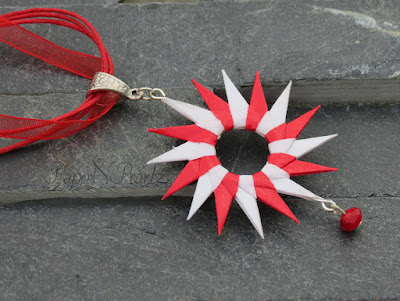This Christmas has been a very busy time for me. I had participated in a couple of Christmas sales and have been busy making paper jewelry! And paper jewelry is time-consuming work! So I didn't get a lot of time to make anything special for Christmas 2014.
One thing that I did try was this modular star. The star is actually made from Bascetta Star modules. The star requires a total of 24 modules. The modules are folded as usual. For assembly, instead of using 3 modules for the pyramids, here we use 4. From then on, it is pretty straight forward. Keep adding modules in a circle. I found it easier to assemble the circle first and then worry about fixing the centre. I used glue to hold the joints well, since I had planned on adding it to my Christmas tree.
The first star that I did was in rainbow colours. I think a better choice of paper would have been paper coloured on both sides, like copy paper. So I did another star with Christmas colours. Very happy with the result this time :)
So that is my Christmas decoration for this year. Hope you have fun with this model :)
A very merry and joyous Christmas to my readers. Have a wonderful day :)
One thing that I did try was this modular star. The star is actually made from Bascetta Star modules. The star requires a total of 24 modules. The modules are folded as usual. For assembly, instead of using 3 modules for the pyramids, here we use 4. From then on, it is pretty straight forward. Keep adding modules in a circle. I found it easier to assemble the circle first and then worry about fixing the centre. I used glue to hold the joints well, since I had planned on adding it to my Christmas tree.
The first star that I did was in rainbow colours. I think a better choice of paper would have been paper coloured on both sides, like copy paper. So I did another star with Christmas colours. Very happy with the result this time :)
So that is my Christmas decoration for this year. Hope you have fun with this model :)
A very merry and joyous Christmas to my readers. Have a wonderful day :)
Model Details:
Model: Modular Star
Creator: Paolo Bascetta
Difficulty Level: Low Intermediate
Paper Ratio: Square
Paper Size: 3 inches
Model Size: ~ 6 inches diameter
Number of Modules: 24
Tutorial Link (for making the modules): Youtube

























































